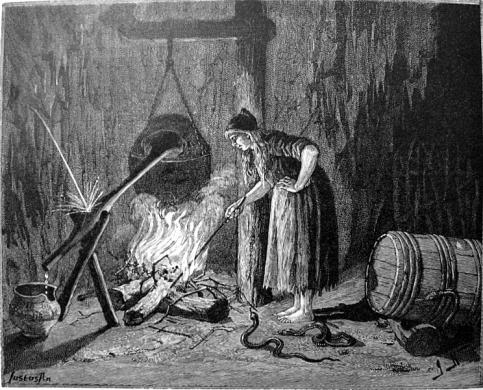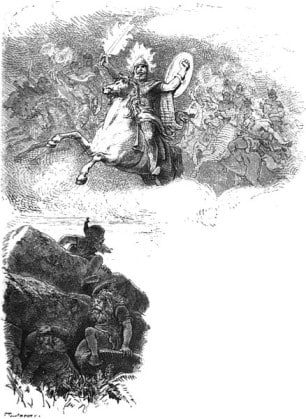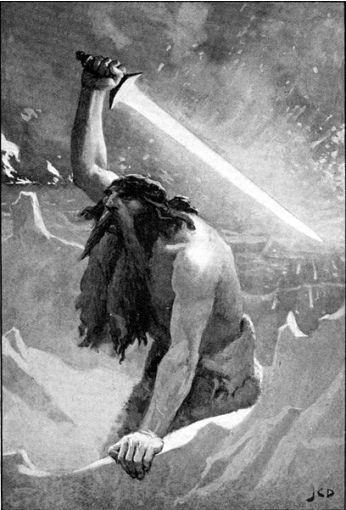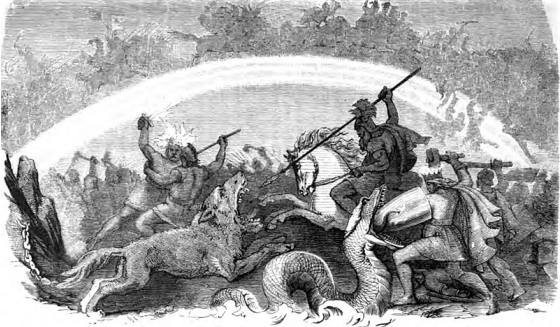The fire-giant Surt (Old Norse Surtr) is the fearsome ruler of Muspelheim. He’s an essential figure in Norse mythology, wielding a fiery sword that can destroy worlds. Surt’s role extends beyond Muspelheim, as we’ll discover when discussing the apocalyptic event, Ragnarök.
As a powerful leader, Surt embodies the fierce nature of Muspelheim. His sword, Surtalogi (or possibly Laevateinn), is said to be so hot that it can set the entire world aflame. The power and authority of Surt will play a crucial role in the events leading to the end of the world.
Surt’s Name and Origins
Surt (Old Norse: Surtr) can be understood to mean “black” and as a name, “the black, or swarthy one”. His name might also be related to “surtur,” an Old Norse term for “black smoke” or “black one.” This is likely because he lives in the realm of fire and volcanoes.
This interpretation further emphasizes the association between Surt and the destructive, chaotic force of fire. Moreover, it establishes a clear connection between Surt and his role as ruler of Muspelheim, the realm of fire.
Interestingly, there is a giant volcanic cave in Iceland called Surtshellir (-hellir meaning cave). It was named so already in the 9th century.
His exact origins in Norse mythology are uncertain, but he is thought to be a descendant of Ymir. Personally I believe Surt is a jötun descendant of Ymir like all of the jötun race. Moreover, all evidence points to him being a fire-giant, or fire-jötun, otherwise similar to other jotnar.
Surts wife Sinmara

Surt has a consort, or possibly a wife, a jötun named Sinmara. This is based on a shared mention in an Old Norse poem called ‘The Lay of Fjölsvinn’ (Old Norse Fjölsvinnsmál). In the poem the hero Svipdag is on a journey to find, and apparently free a woman called Menglöd. The fair maiden is held captive in a castle guarded by an imposing guardian.
Trying to discern how he might gain entry, Svipdag is in a dialogue with the guard outside (believed to be Odin). Basically it’s an impossible task that is a bit of a chicken and egg dilemma.
In stanza 24. Surt is mentioned along with Sinmara (Old Norse: Sinmöru).
Old Norse:
Fjölsviðr kvað:
- “Víðópnir hann heitir, en hann stendr veðrglasir
á meiðs kvistum Míma;
einum ekka þryngr hann örófsaman
Surtr Sinmöru.”
English translation:
Fjolsvith spake:
- “Vithofnir is his name, | and he stand shining
Like lightning in the branches of Mimameith;
And great is the trouble | with which he grieves
Surt and Sinmara.”
Decoding The Lay of Fjölsvinn
This is taken a bit out of context so I’ll try to explain. Vithofnir is one of the two roosters living in the top branches of Yggdrasil. Moreover, for some unknown reason, Yggdrasil is named Mimameith. It is prophesied that the rooster will call when Ragnarök starts.
Based on the above-shared mention, and a few more about Sinmara’s role, several scholars name her as Surt’s wife. Other than her, nothing else is known about a possible family. From other mentions about the fire-giants marching on Asgard under Ragnarök it is clear they are many. They are just called “Sons of Muspel” which could be based on them coming from Muspelheim. However, there could possibly be some closer connection to Surt that we have lost knowledge of.
Surt is the ruler and guardian of Muspelheim

Muspelheim is, along with Niflheim, one of the two primordial realms in Norse cosmology. The heat from Muspelheim melted the icy plains and rivers that stretched from Neiflheim into the void of Ginnungagap. That primordial pool gave life first to the jötun Ymir and the cow Audhumla. The cow, licking salt ice rocks, then uncovered Búri, first of the Aesir from the ice.
Nothing is ever said about how Surt came to be the guardian and ruler of Muspelheim. However, he seems to be an almost-primordial being. Muspelheim is such a forbidding realm that only the ones native to the place are said to be able to live there.
As described in ch IV. of Gylfaginning
“Then added Thride: Still there was before a world to the south which is called Muspelheim. It is light and hot, and so bright and dazzling that no stranger, who is not a native there, can stand it.
Surt is the name of him who stands on its border guarding it. He has a flaming sword in his hand, and at the end of the world he will come and battle, conquer all the gods, and burn up the whole world with fire.”
Surt’s dominion over this realm grants him considerable power and influence within the cosmos of the Norse. As the ruler of Muspelheim, he also holds sway over the fire giants and any other beings that might reside there, making him a formidable force in the mythic narrative.
Play Jötunn Quiz
Do you want to learn more about the magical and powerful Jötunn? Then test your knowledge with this fun quiz game!
Don’t forget to play our other games as well!
Surts’ flaming sword Surtalogi
Surt wields a powerful weapon, a giant sword described as fiery or flaming, able to set whole worlds on fire. There are a few theories flying about regarding this sword. However, the only one I am inclined to believe is that the sword’s name likely was Surtalogi, meaning “Surts fire”. This is posed by the Norse mythology scholar Rudolf Simek in his Lexicon of Germanic mythology.
Some speculate that somehow Surt had gotten hold of Freyr’s own sword (which remains nameless) but no texts support this. In Skirnismál we only learn that Freyr gives the sword to Skirnir, but there is no reason to believe it ends up with anyone else.
Also, there is a theory that Surt’s sword is the Laeveteinn, a weapon said to have been crafted by Loki at the very gates of Hel. However, this seems to be based on a misunderstanding of the aforementioned poem “The Lay of Fjölsvinn”. In it, the sword (or possibly wand) Laeveteinn is mentioned as the only weapon capable of killing the rooster Vithofnir. Further, we learn that to prevent this, the weapon is safely locked away with nine locks, and guarded by Sinmara.
Its ability to kill the rooster seems to be the reason why it poses a threat to Surt. Moreover, this is why it’s locked away, definitely not something Surt has been wielding since the beginning of time.
From the “The Lay of Fjölsvinn” stanza 26
Fjolsvith spake:
“Lævatein is there, that Lopt with runes
Once made by the doors of death;
In Lægjarn’s chest[d]
by Sinmora lies it,
And nine locks fasten it firmly.”

The role of Surt in Ragnarök
In Norse mythology, Ragnarök signifies the end of the world as we know it, with gods, giants, and other creatures engaging in cataclysmic battles. Among these epic confrontations, one of the most notable is the meeting between the fire giant Surt and the fertility god Freyr on the battlefield of Ragnarök. This encounter holds significant importance, as it symbolizes the clash of opposites: the destructive power of fire against the life-giving essence of fertility.
Freyr, the god of fertility, harvest, and prosperity, is a member of the Vanir gods, a group separate from the more well-known Aesir gods. He is known for his magical sword, which is said to be able to fight on its own, making him nearly unbeatable in combat. However, Freyr gave up his sword to win the hand of the beautiful giantess Gerd in marriage. This decision ultimately proves to be costly, as Freyr is left without his powerful weapon when he faces Surt in battle.
Surt fighting Freyr on the plain of Vigrid

When Surt and Freyr finally meet on the battlefield, it is a clash of titans. Freyr, despite being a skilled warrior, is at a significant disadvantage without his magical sword. Surt, on the other hand, wields Surtalogi, a weapon that enhances his already fearsome power. Their confrontation is fierce and intense, but ultimately, the outcome is bleak for Freyr. It is prophesied that Surt will defeat and slay Freyr, dealing a severe blow to the gods’ forces during Ragnarök.
In the aftermath of Ragnarök, Surt sets fire to the world, engulfing it in flames. This act of destruction leads to the rebirth of the cosmos, as a new world emerges from the ashes. Surt’s pivotal role in Ragnarök underlines his significance in Norse mythology as a powerful force of change and transformation. His actions during the end times serve as a reminder of the cyclical nature of the cosmos and the enduring struggle between chaos and order.
Last thoughts on Surt
Surt’s significance in Norse mythology is undeniable. As a powerful force of chaos and destruction, his presence in the mythological narrative serves as a constant reminder of the delicate balance between order and chaos.
All life and the worlds themselves were created where the realms of Niflheim and Muspelheim met in Ginnungagap. It is only fitting then that it all comes to a fiery end at the hand of the ruler of Muspelheim. In Surt’s destruction of the worlds, the cycle of creation and life starts anew.
FAQs
Surt is a fire giant in Norse mythology, known for ruling the realm of Muspelheim and playing a pivotal role in Ragnarök, the end of the world.
Surt’s name is derived from Old Norse and is possibly linked to the terms “black” or “swarthy,” emphasizing his connection to darkness and the soot produced by fire.
Surt is closely connected to Muspelheim, the realm of fire in Norse cosmology, as its ruler or chieftain, and he also serves as the guardian of this fiery world.
During Ragnarök, Surt leads an army of fire giants against the gods, fights and kills the god Freyr, and ultimately sets the world ablaze, paving the way for its rebirth.
Surt is depicted with flaming hair and a beard, glowing red eyes, and a charred, blackened body, symbolizing his connection to fire and its destructive power.
Featured Image Credit: Lorenz Frølich, Public domain, via Wikimedia Commons
